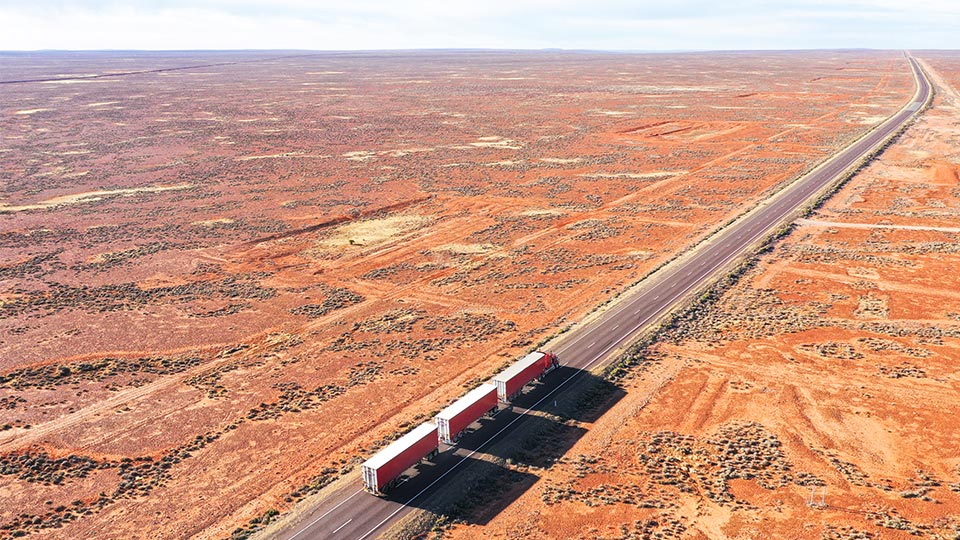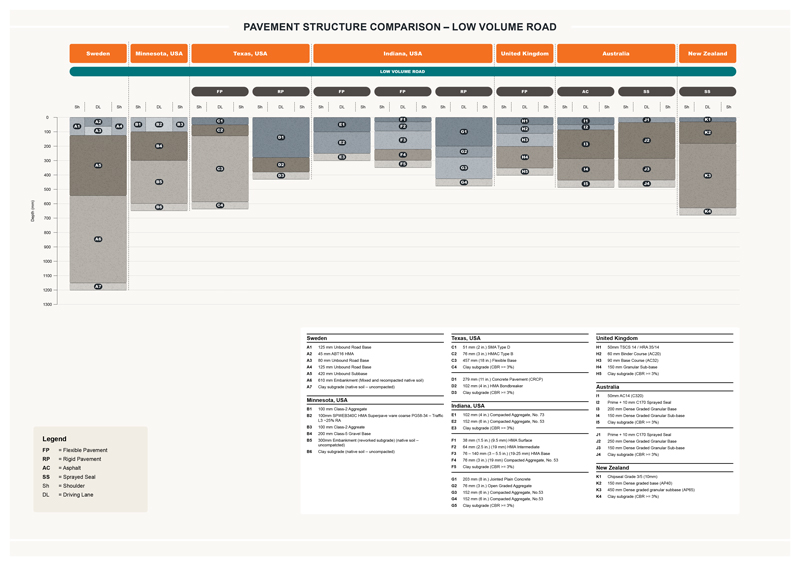Friday, 7 February 2025

Australia’s freight industry is at a turning point. The transition to low and zero-emission heavy vehicles (ZEHVs) is critical to achieving net zero targets, but it presents significant challenges for road infrastructure. As these vehicles are often heavier than their diesel counterparts, they place additional strain on pavements and bridges—potentially increasing maintenance costs and accelerating road deterioration.
Australia has a long history of engineering cost-effective road networks, enabling an extensive transport system despite the country’s vast geography and relatively low population density. However, as transport emissions come under greater scrutiny, government and industry leaders must navigate complex trade-offs between sustainability, infrastructure resilience, and freight efficiency.
A new Austroads report explores these challenges and outlines potential pathways for government and industry to support the decarbonisation of heavy transport while ensuring Australia’s road network remains functional and cost-effective.
Key considerations
|
Australia’s Cost-Effective Approach to Road Building
Australia’s road engineers are global leaders in cost-effective infrastructure. As a vast country with a relatively small population, we’ve had to be both prudent and practical in the way we build and maintain our roads.
Following World War II, Australia’s population was booming, and road authorities faced a choice: build roads frugally or build fewer of them. The National Association of State Road Authorities (Austroads’ predecessor) worked with road departments to pioneer thin pavement designs—reliable, cost-effective solutions that could withstand expected traffic loads with appropriate maintenance. As a result, Australia was able to construct 30–40% more kilometres of road in less time than many other parts of the world.
This commitment to efficiency led Austroads to standardise thin pavement designs, ensuring that taxpayers' money was used wisely. For over 60 years, Australians have benefited from an extensive road network that delivers both reach and reliability.
For the most part, these roads have withstood increasing freight demands, even as trucks have become heavier and placed greater strain on pavements—compressing road surfaces and stretching bitumen as they stop, start, and turn.
Now, however, an even greater challenge is emerging. As Australia moves toward lower and zero-emission heavy vehicles, many of these trucks are even heavier than their diesel counterparts, raising concerns about their suitability for our existing road network.
Balancing pavement durability with environmental benefits is a complex challenge. That’s why Austroads has produced a report highlighting the intricacies of reducing emissions in heavy vehicle operations—an industry with high energy demands and diverse operational needs.
The Challenge of Heavy Vehicle Decarbonisation
The transition to low and zero emission heavy vehicles (ZEHVs) requires evolving technologies such as battery-electric and hydrogen fuel cells. Current solutions, while promising, entail increased tare mass—meaning the vehicles themselves are heavier compared to their internal combustion engine counterparts.
An increase in tare mass could reduce payload capacity, potentially diminishing commercial viability, particularly for weight-constrained freight operations.
The freight industry has advocated for “payload parity,” arguing that road managers should allow higher mass limits to offset the heavier tare weight of these new vehicles. Without these adjustments, the industry points out that operators may be discouraged from transitioning to low or zero emission fleets due to the potential impact on operational efficiency.
Weighing the Infrastructure Implications
The request for increased mass limits presents a significant challenge for road managers, as any increase in vehicle weight impacts infrastructure, including road pavements, bridges, and culverts. This issue is not unique to Australia and New Zealand—governments worldwide are exploring the best strategies to facilitate the adoption of ZEHVs while managing infrastructure constraints.
Australia and New Zealand’s road networks, particularly in rural areas, rely heavily on flexible pavements made from locally sourced materials. These lower-cost pavements are less robust than the rigid pavements commonly used in the United States and the United Kingdom for intercity freight routes. However, their use in Australia is a rational choice, as flexible pavements are more cost-effective to construct and maintain, particularly in regions with vast road networks and lower traffic volumes. Given the expansive rural road system and the need for economic efficiency, rigid pavements would present a prohibitively high cost in both initial construction and ongoing maintenance. Flexible pavements also provide the advantage of easier and more rapid repairs, which is crucial for maintaining connectivity in remote and regional areas where heavy freight transport is essential for economic activity.
Additionally, rural roads serve as a lifeline for many communities, providing essential connectivity for businesses, emergency services, and the movement of goods and people. Increased deterioration of these roads due to higher mass limits could have significant social and economic implications, particularly in remote areas where alternative routes are limited. Ensuring the longevity and reliability of these roads is critical for supporting regional economies and maintaining access to vital services.
As a result, road managers in Australia and New Zealand must carefully assess the impact of any increased mass limits on pavement longevity and maintenance costs.
Learning from International Approaches
A comparative review of heavy vehicle policies in Sweden, the UK, and the US provides valuable insights for Australia and New Zealand. The findings reveal key differences in mass limit policies and infrastructure capabilities:
- United States: National-level mass limits have remained largely unchanged for the past 50 years, primarily due to bridge capacity constraints.
- United Kingdom: The government increased the maximum gross vehicle mass by two tonnes for ZEHVs, but only where it did not exceed the total limit of 44 tonnes.
- Sweden: Mass limits are generally higher than those in continental Europe, facilitated by road designs that accommodate cold weather conditions.

Notably, Australia and New Zealand have lower axle mass limits compared to these countries, but vehicle mass constraints are less restrictive, meaning operators can fully utilise their axle capacity. Any changes to mass limits must therefore consider infrastructure resilience, economic impacts, and international vehicle design trends.
Pathways for Governments
The report outlines three potential directions for governments seeking to balance decarbonisation goals with infrastructure sustainability:
- Maintain payload – Increase permissible mass limits to accommodate heavier tare weight without reducing payload capacity.
- Maintain gross mass – Keep total mass limits unchanged, requiring operators to accept lower payloads.
- Allow axle group mass substitution – Provide flexibility in redistributing weight across axles without exceeding total gross vehicle mass.
Each option presents trade-offs, requiring decision-makers to carefully evaluate infrastructure constraints, economic implications, and environmental objectives.
Key Conclusions and Future Considerations
Decarbonisation of road freight is essential to achieving net zero targets, but determining the right approach requires balancing infrastructure, environmental, and economic impacts. Compared to some international jurisdictions, Australia and New Zealand's road infrastructure is less suited to supporting increased mass limits for ZEHVs. Previous increases in mass limits have already tested the capacity of pavement infrastructure, making further increases a significant challenge.
While international examples provide valuable insights, ANZ’s approach must reflect local infrastructure realities, freight industry needs, and broader economic considerations. If mass limits are increased, governments will need to either increase maintenance funding to mitigate accelerated road deterioration or accept a decline in road service levels, which could impact all road users through congestion, road safety concerns, and deteriorating road quality.
Conversely, if mass limits remain unchanged and the freight industry transitions to ZEHVs through other incentives, private industry will face higher transport costs that will likely be passed on to consumers. Additionally, more vehicles may be needed to perform the same freight tasks, potentially worsening congestion, increasing pavement damage, and posing road safety risks.
While technological advancements are expected to mitigate some of these challenges over time, considered responses are needed in the short term to ensure a smooth transition.
Further Research Directions
The report identifies several key areas for further investigation:
- Comparing maintenance and funding strategies in ANZ with those of international jurisdictions.
- Analysing ANZ logistics and freight task characteristics to inform future policy decisions.
- Exploring modal substitution between road and rail freight and its potential influence on heavy vehicle access and mass policy.
- Investigating cost recovery mechanisms for road maintenance and their impact on cost-benefit assessments of increased mass limits.
- Assessing embodied carbon impacts of increased maintenance needs, particularly in relation to emission reductions in the transport sector.
- Evaluating electric heavy vehicle operating costs, including potential savings in vehicle maintenance using models such as the ATAP Vehicle Operating Cost Model.
As the deadline for net zero targets approaches, governments must navigate these complexities to ensure a sustainable, cost-effective, and efficient transition to a decarbonised freight sector.
Find Out More
For a comprehensive analysis download the full report here.
Join us for a webinar on the report, presented by Harriet Farminer, Andrew Somers and Michael Bushby.
There will be question and answer opportunities during the session. No charge but registration is essential. Can’t make the live session? Register and we’ll send you a link to the recording.
